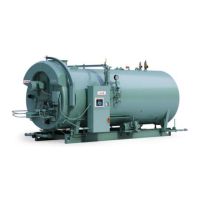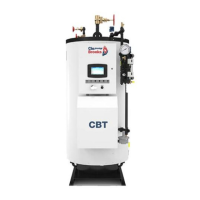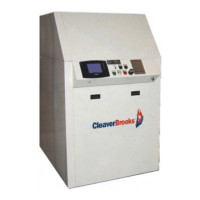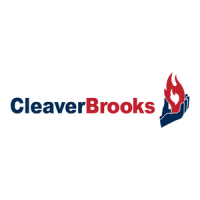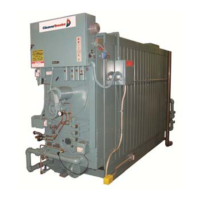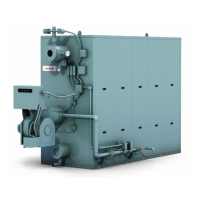750-392
CBEX-DE
2-13
Preparation for Extended Layup
Have available information on the boiler design, dimensions, generating capacity, operating pressure or tempera-
ture, time in service, defects found previously, and any repairs or modifications. Also have available for reference
records of previous inspections.
Be prepared to perform any testing required by the inspector including a hydrostatic test.
After proper cooling and draining of the vessel, flush out the waterside with a high pressure water hose. Remove
any scale or deposits from the waterside surfaces and check for internal or external corrosion and leakage.
The fireside surface should also be thoroughly cleaned so that metal surfaces, welds, joints, tube ends, fittings
and any previous repairs can be readily checked.
Be sure that steam valves, and valves to expansion tank (hot water), feedwater valves, blowoff valves, all fuel
valves, and electrical switches are shut off prior to opening handholes, manhole, and front or rear doors. Ade-
quately vent the pressure vessel prior to entry.
Clean out the low-water cutoff piping, the water level controls and cross-connecting pipes. Replace the water
gauge glass and clean out the water cocks. Also check and clean the drain and the blowdown valves and piping.
Check all water and steam piping and valves for leaks, wear, corrosion, and other damage. Replace or repair as
required.
2.9 — Preparation for Extended Layup
Many boilers used for seasonal loads or for standby service may have extended periods of non-use. Special atten-
tion must be given to idle boilers so that neither waterside nor fireside surfaces are allowed to deteriorate from
corrosion.
There are two methods of storage: wet or dry. Your local Cleaver-Brooks authorized representative can recom-
mend the better method depending upon circumstances in the particular installation.
Although pollution control regulations may continue to limit the permissible sulphur content of fuel oils, care
must be taken to avoid corrosion problems that sulphur can cause, especially in a boiler that is seasonally shut
down. Dormant periods, and even frequent shutdowns, expose the fireside surfaces to condensation below the
dew point during its off cycle. Moisture and any sulphur residue can form an acid solution. Under certain condi-
tions, and especially in areas with high humidity, the corrosive effect of the acid will be serious enough to eat
through or severely damage boiler tubes or other metal heating surfaces during the time that a boiler is out of ser-
vice.
The condition does not generally occur during normal firing operation, because the high temperature of operation
vaporizes any condensation. However, proper boiler operation must be maintained, especially with a hot water
boiler, to prevent the flue gases from falling below the dew point.
At the start of layup, thoroughly clean the fireside by removing any soot or other products of combustion from the
tubes, tube sheets, and other fireside surfaces. Brushing will generally suffice. Sweep away or vacuum any accu-
mulation. The fireside surfaces may be flushed with water. However, all moisture must be eliminated after flush-
ing and the surface dried by blowing air or applying some form of heat. It is good practice to protect the cleaned
surfaces by coating them with an anti-corrosive material to prevent rust.
Swing open the boiler head at the stack end of the unit to prevent flow of warm, moist air through the boiler
tubes.
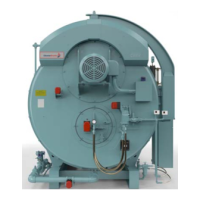
